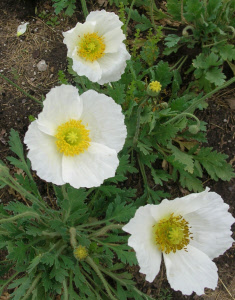Description
Paper-thin petals on this pure white poppy wth yellow stamens blooms all summer and fall – June to October, and November if it’s mild. Absolutely one of our favorites.
Paper-thin petals on this pure white poppy
Paper-thin petals on this pure white poppy wth yellow stamens blooms all summer and fall – June to October, and November if it’s mild. Absolutely one of our favorites.
OUT OF STOCK
Lavender-Pink outside and white inside funnels in June
Size: 20” x 12-24”
Care: sun in well-drained soil
Native: northeast North America
Wildlife Value: feeds native bees, Baltimore butterfly and endangered Rusty patched Bumble Bee
Penstemon is named for its five stamens, penta meaning “five” and stemon meaning “stamen” in Greek. Penstemons are “handsome and deserving,” Bailey. P. hirsutus sent from America to England in 1758.
Profusion of small classic daisies May-July atop fragrant silver foliage. Cut back for rebloom. Let the seeds drop for more plants next year. If you cut them back after the 1st flowering they will rebloom for most of the summer and fall.
Size: 2’ x 3’
Care: sun in moist well drained soil
Native: central & southern Europe
Named by Carl Heinrich Schultz (1805-1867)
OUT OF STOCK
Rosettes of succulent leaves
Size: 4” x 4”
Care: sun in well-drained to moist well-drained soil
Native: Alps & Pyrenees Mountains
Grown in gardens for thousands of years. Sempervivum means “live forever.” Romans planted Hens and chicks on their roofs to ward off lightning. As a succulent it holds water and is probably more difficult to catch fire. “This practice was preserved for historians when Charlemagne (720-814), first Holy Roman Emperor and unifier of a large part of northern Europe, ordered that all villagers within his crown lands plant houseleeks on their roofs, presumably as a safety measure. He decreed: Et ille hortulanus habeat super domum suam Iovis barbam. (And the gardener shall have house-leeks growing on his house. Capitulare de villis, about 795, LXX.)”
Fast-growing, pyramidal-shaped deciduous conifer. The orange to brown trunk base tapers and thickens with up to a dozen large buttress-like root flares extending several feet up the trunk. Feathery, fern-like, soft foliage emerges light green in spring, and turns red-bronze in fall before dropping. Its branches are well-attached and make excellent climbing.
Size: 70-90’ x 15-25’
Care: sun in moist to moist well-drained, slightly acid soil
Native: Szechuan China
Awards: Royal Botanic Garden Award of Garden Merit, Yew Dell Botanical Gardens’ Theodore Klein Plant Awards & Pennsylvania Horticultural Society Gold
From fossil records, dawn redwood is known to have existed as many as 50,000,000 years ago. However, it was not until 1941 that dawn redwood was first discovered growing in the wild near the town of Modaoqi China by Chinese forester, T. Kan. Seeds collected from the original site were made available to the Missouri Botanical Garden in 1947. Seedlings grown therefrom were planted in front of the Lehmann Building at MBG in 1952 where they have now developed into large mature trees (70’+ tall). Dawn redwood is a deciduous, coniferous tree that grows in a conical shape to 100’ tall. It is related to and closely resembles bald cypress (Taxodium) and redwood (Sequoia).

